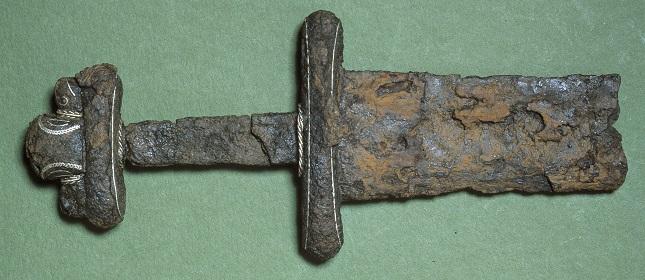Viking swords

A sword marks the deadly, pivotal point in the story of Offa of Angel, who is one of the most famous heroes of the Danish legends. The king’s son, Offa, is to engage in combat with two Saxons, but the swords that he has been given break when he tries to use them. His old, blind father King Wermund decides to have his old sword “Skræp” dug up from the ground, where it has lain since he became too old to use it effectively.
Offa is equipped with this family heirloom and uses it to defeat the two Saxons. Every time the sword cuts Offa’s opponents, King Wermund cries out ”that was Skræp that struck!” The story illustrates the great importance that was attached to the sword as a weapon. Sharp swords could sometimes even be given names, as in the story about Offa. Swords with names are involved in several other stories. For example, Sigurd carries a special sword called Gram, which was forged from his father’s broken sword.
To learn more about these powerful weapons we must turn to the archaeological evidence. Here a large number of swords can provide us with much more information.
The Vikings’ swords were normally around 90 cm long. They were usually double-edged and could be domestically produced or imported from the Frankish Empire. The blades were sometimes decorated with pattern welding.
Materials and decoration
The hilts of the swords were of various shapes and were made of bone, antler or precious metals such as gold and silver. The sword was an expensive weapon and therefore much effort was put into decorating its handle. The pommel, which acted as a counterweight to the blade so that the sword balanced, could display inlays of precious metals or intricate patterns. The blade itself often had “blood grooves” running along its middle. These saved valuable metal and made the sword lighter.

Swords as gifts and offerings
We are familiar with Viking swords from various burials, which mainly date to the early Viking period. It was most often people of high status who were buried with swords in the Viking Age. Not all Viking warriors had a sword; they were prestige weapons. Swords were highly valued objects and could be handed down from generation to generation. They were also given as gifts to people of high status in order to stay on good terms with them.
Viking swords were also used in another way. This was the tradition of sacrificing the valuable swords in lakes and bogs. Many swords, spears and lances from the Viking and early medieval periods have also been found near fords crossing rivers and in wetlands. Perhaps the weapons were left at such locations as an offering, or else they were simply dropped and lost during the attempt to cross the water.
Copied swords

Some of the finest sword blades that the Vikings could acquire were imported from the Rhine area. Their blades bore the name ”ULFBERTH”, which denoted the best swords of the time made of high quality steel. Ulfberth may have been the master, who was responsible for the production of these swords in the Frankish Empire during the 9th century. However, the swords were made up until the 11th century, so the name must subsequently have been used for the products of a particular workshop.
The Ulfberth swords became so popular that a ban had to be placed upon their export. This was imposed to limit the Vikings’ access to these quality swords, which they were using very effectively to ravage the coasts of the Frankish Empire. However, as a result smiths in territories neighbouring the Frankish Empire began to produce sword blades and copy the name ULFBERTH onto them. Both genuine and imitation ULFBERTH swords have been found throughout large parts of Europe. The imitations, however, are often of a distinctly lower quality than the genuine examples.
